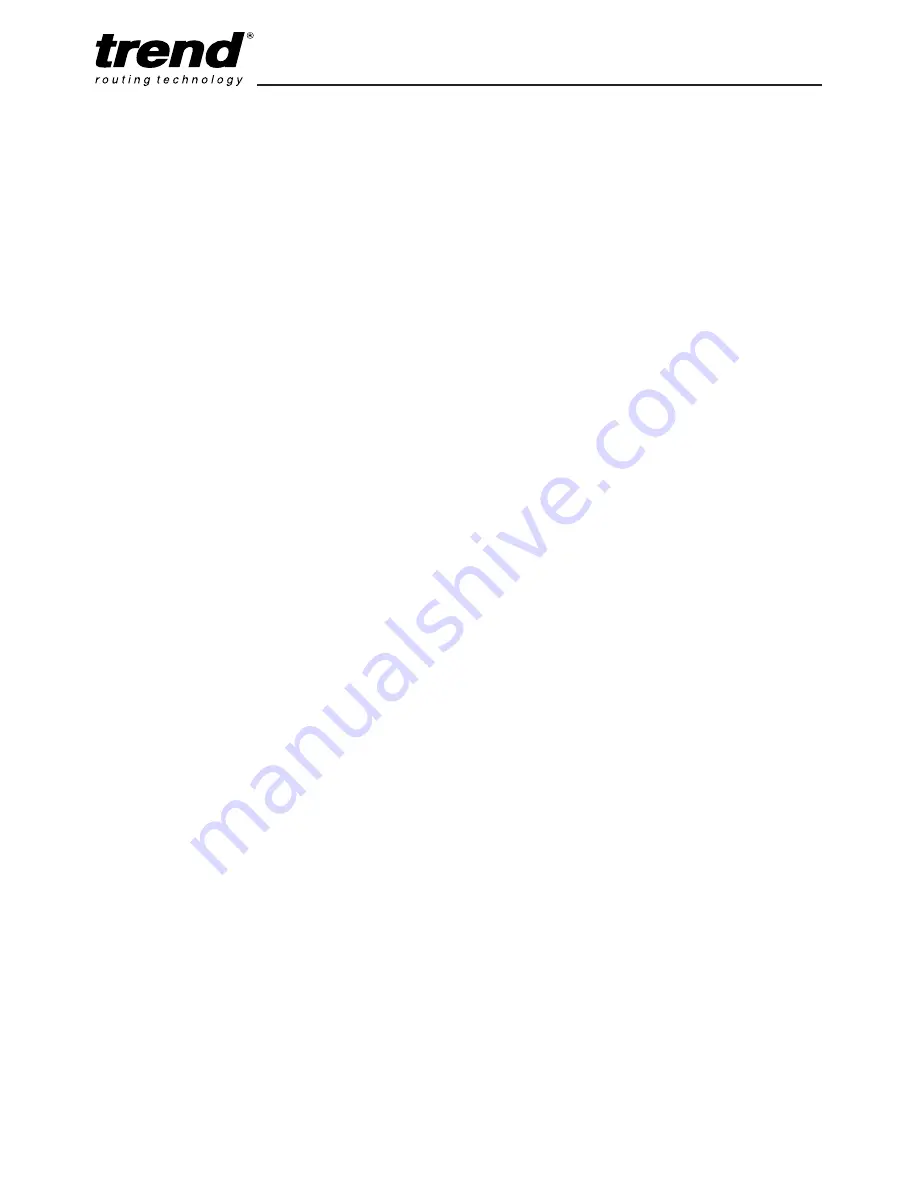
-3-
T3 - USA
Additional Safety Rules For Router
Bits
■
Cutting tools are sharp. Care should
be taken when handling them.
■
Always use router bits with a shank
diameter corresponding to the size of
the collet installed in your tool.
■
Always run router bits at the spindle
speed recommended and marked
accordingly. Ensure bit has reached
correct speed before entering
workpiece. Recommended speeds
can be found on the packaging, in
cutter instructions or in the Trend
Routing Catalogue.
■
Always use router bits in a router.
Router bits must not be used in a
drill. Drill and boring bits must not be
used in a router. Router bits must
only be used for the material cutting
application for which they are
designed. Do not use on metal or
masonry.
■
Never use router bits with a diameter
exceeding the maximum diameter
indicated in the technical data of the
powertool or attachment used.
■
Do not drop router bits or knock them
against hard objects. Do not use
router bits that are damaged.
■
Router bits should be kept clean.
Resin build up should be removed at
regular intervals with Resin
Cleaner®. The use of a dry lubricant
(Trendicote
®
PTFE) will act as a
preventative. Do not use PTFE spray
on plastic parts.
■
Router bit shanks should be inserted
into the collet to the mark line on the
shank. This ensures that at least
3
⁄
4
of
the shank length is held in the collet.
Do not over-tighten the collet nut as
this will score the shank and create a
weakness and fracture point.
■
Observe the correct assembly
instructions in the router instruction
manual for fitting the collet and nut.
Observe the router power tool
manual instructions on fitting bits
correctly.
■
It is advisable to periodically check
the collet and collet nut. A worn,
distorted or damaged collet can
cause vibration and damage the
shank, and should be replaced. Worn
collet nuts should be replaced.
■
Do not take deep cuts in one pass;
take several shallow or light passes
to reduce the side load applied to the
router bit. Too deep a cut in one pass
can stall the router.
■
Very small diameter router bits must
be handled and used with care.
■
Always return router bit to its
packaging after use.
■
Should you experience excessive
vibration during use stop
immediately. Have the eccentricity of
the router, router bit and clamping
system checked.
■
All fastening screws and nuts should
be tightened using the appropriate
wrench or key in accordance with
the manufacturers instructions.
■
When using arbor type multi-groover
sets ensure that the groover cutting
tips/wings are staggered at 90
º
to
each other to reduce the cutting
impact.
Using Routers In A Fixed Position
■
After work, release the router plunge
to protect the router bit.
■
Always use a push-stick or push-
block for last 12” of the cut.
■
Whenever possible use a work
holding device or jig to secure
component being machined. Fit a
spelch block to the holding device or
mitre fence to prevent break out on
the timber.
■
Ensure attachment is securely fitted
to the workbench, with table surface
at approximately hip height.
■
Ensure a No-Volt Release Switch is
fixed to or adjacent to the
attachment and that it is used
correctly.
■
Check the feed direction of the
workpiece is always opposite to the
router bits direction of rotation.
Ensure that, when using a router
table, you stand to the front right
hand side of the table (when viewed
from the front) and feed from right to
left. When using an overhead
router, stand to the front left hand
side (when viewed from the front)
and feed left to right.
■
Do not use awkward or
uncomfortable hand positions.
■
Do not reach underneath table or
put your hands or fingers at any time
in the cutting path while tool is
connected to a power supply.
Useful Advice When Routing
■
Trial cuts should be made on waste
material before starting any project.
■
Judge your feed rate by the sound of
the motor. Feed the router at a
constant feed rate. Too slow a feed
rate will result in burning.
■
Take many light passes rather than
one deep cut to reduce the side load
applied to both router and router bit.
■
When using some attachments
including a router table or dovetail
jig, the use of a fine height adjuster
is highly recommended.
■
When using a template guide bush,
ensure there is sufficient clearance
between router bit tip and inside
each of bush. Ensure router bit and
guide bush are concentric.
Router Bit Maintenance
■
Composite cutting tools (brazed tip)
must be maintained by a competent
person i.e. a person of training and
experience, who has knowledge of
the design requirements and
understands the levels of safety to
be achieved.
■
The design of composite tools must
not be changed in the process of
maintenance.
■
Replacement parts must meet Trend
specification.
■
Tolerances which ensure correct
clamping by the collet shall be
maintained.
■
When re-grinding the tool, care must
be taken not to cause weakening of
the body or the connection between
the cutting edge and the body.
Version 5.0 05/2004
Summary of Contents for T3-USA
Page 1: ...T3 PLUNGE ROUTER USA ...



















